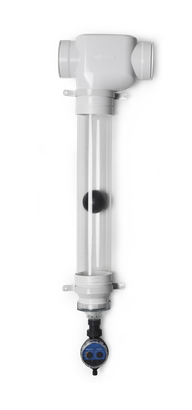Free or Fixed Shipping
On most products!
Need Help With Installation?
With decades of field experience we'll walk you through each step of your installation.
Field Tested
Quality products, lowest prices guaranteed!
Price Match
Found a better price? We'll match it. Contact us for our price match guarantee!
Downspout First Flush Water Diverter Advanced 4"
ADVANCED FIRST FLUSH DIVERSION FOR RAIN SYSTEMS!
NOTE: We only recommend first flush diverters in warm climates. Using these in winter climates could result in the unit breaking if the standpipe isn't fully drained during freezing temps. For winter climates, consider using our Wisy Vortex Filters or our Monjolin Filters in lieu of first flush.
Downspout First Flush Water Diverters improve water quality and reduce tank maintenance by preventing the first flush of water, which may contain roof contaminants, from entering the tank. They help ensure cleaner water is available for use, which protects rainwater pumps and internal household appliances such as clothes washing machines, toilets, hot water systems, etc.
The New First Flush Water Diverter ADVANCED
allows less "dirty" water to skip over the first flush chamber. The tee incorporates a unique flow direction feature that forces fast-flowing water into the diversion chamber, preventing the water from entering your rainwater tank. With this kit, 4x less "dirty" water bypasses the diversion chamber, and 97% of first flush water is diverted.
This Advanced model improves upon the First Flush Water Diverter Plus
by adding an electronic advanced release valve, giving you greater control over how frequently you release your diverted water. Increase your release frequency to maximize water quality or release the dirty water less frequently to maximize stored water volumes.
FEATURES AND BENEFITS
- Prevents sediment, bird droppings, spiders, insects, mosquito eggs and debris from entering the rainwater tank.
- Improves water quality, protects pumps and internal appliances.
- Ideal to use in conjunction with a rain head.
- Easy installation, just add pipe and glue.
- No mechanical parts.
- Low maintenance requirements.
HOW DO THEY WORK?
Supplied in kit form, the First Flush Diverter Advanced can be installed on your downspouts with a simple T junction. Simply add and install the length of pipe required to meet your diversion needs. This will be based on the volume of dirty, contaminated water you wish to divert.
Fitting an appropriately sized First Flush Water Diverter is critical to achieve good quality water. Water Diverters improve water quality, reduce tank maintenance and protect pumps by preventing the first flush of water, which may contain contaminants from the roof, from entering the tank.
When it rains, water slowly builds up in the roof guttering system before it exits through the downspout. The first flush of water from the roof can contain amounts of bacteria from decomposed insects, bird and animal droppings and concentrated tannic acid. It may also contain sediments, water borne heavy metals and chemical residues, all of which are undesirable elements to have in a water storage system.
*Not recommended for winter climates*
HOW MUCH WATER TO DIVERT?
It is important to prevent heavy sediments and other roof pollutants from entering the rainwater tank/cistern. The amount of water diverted should be a minimum of 12.5 gallons per 1000 square feet of roof area (or 0.0125 gallons per square foot). In calculating the amount of water to divert, consideration can be given to (1) the surface area of the roof, and (2) the amount of pollutants on the roof and gutters.
The following factors can be used as a guide in determining the volume of water to be diverted.
As a rule of thumb, the more water that is diverted, the better the quality of water in the tank/cistern.
Installation & Specification Guide


